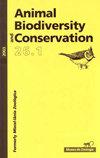家犬对巴西两个热点地区野生动物的影响及其对保护的影响
IF 1
4区 环境科学与生态学
Q3 BIODIVERSITY CONSERVATION
引用次数: 8
摘要
家犬(Canis familyaris)对巴西两个热点地区野生动物的影响以及对保护的影响。外来物种是世界范围内生物多样性的主要威胁。家犬(Canis familyaris)是世界上最常见的入侵性捕食者之一,以多种方式与野生动物互动。我们提供了基于相机陷阱和偶尔观察到的来自巴西大西洋森林和塞拉多热点地区的自由漫游家狗的生态数据。家犬是数量第二丰富的哺乳动物,也是数量最多的食肉动物。狗追逐、杀死和/或与至少26种本土物种竞争。它们没有吃掉任何被杀死的动物,再加上白天单独行动的主要记录表明,它们主要是自由漫步的狗,依靠人类提供食物和住所。大量的狗和广泛的猎物表明,野生动物可能会受到家养狗的巨大影响,尤其是在生物多样性热点等受到人类活动高度威胁的地区。我们强调了可能采取的措施(如将狗从自然区域根除或清除),这些措施有助于减少该地区家养狗对环境造成的破坏。本文章由计算机程序翻译,如有差异,请以英文原文为准。
The impacts of domestic dogs (Canis familiaris) on wildlife in two Brazilian hotspots and implications for conservation
The impacts of domestic dogs (Canis familiaris) on wildlife in two Brazilian hotspots and implications for conservation. Exotic species are major threats to biodiversity worldwide. Domestic dogs (Canis familiaris) are among the most common invasive predators in the world, interacting with wildlife in many ways. We present ecological data based on camera traps and occasional observations of free–roaming domestic dogs from localities within the Brazilian Atlantic forest and Cerrado hotspots. Canis familiaris was the second most abundant mammal species, and the most abundant carnivore. Dogs chased, killed, and/or competed with at least 26 native species. They consumed none of the killed animals, which together with the predominant records of solitary individuals acting during the daytime indicates they are mainly free–roaming dogs relying on humans for food and shelter. The high numbers of dogs and the wide range of prey suggest wildlife could be greatly impacted by domestic dogs, especially in areas that are highly threatened by anthropogenic activities, such as biodiversity hotspots. We highlight possible measures (such as the eradication or removal of dogs from natural areas) that could help to reduce the environmental damage caused by domestic dogs in the region.
求助全文
通过发布文献求助,成功后即可免费获取论文全文。
去求助
来源期刊

Animal Biodiversity and Conservation
农林科学-动物学
CiteScore
2.00
自引率
0.00%
发文量
21
审稿时长
>12 weeks
期刊介绍:
Animal Biodiversity and Conservation (antes Miscel·lània Zoològica) es una revista interdisciplinar, publicada desde 1958 por el Museu de Ciències Naturals de Barcelona. Incluye artículos de investigación empírica y teórica en todas las áreas de la zoología (sistemática, taxonomía, morfología, biogeografía, ecología, etología, fisiología y genética) procedentes de todas las regiones del mundo. La revista presta especial interés a los estudios que planteen un problema nuevo o introduzcan un tema nuevo, con hipòtesis y prediccions claras, y a los trabajos que de una manera u otra tengan relevancia en la biología de la conservación. No se publicaran artículos puramente descriptivos, o artículos faunísticos o corológicos en los que se describa la distribución en el espacio o en el tiempo de los organismes zoológicos.
 求助内容:
求助内容: 应助结果提醒方式:
应助结果提醒方式:


